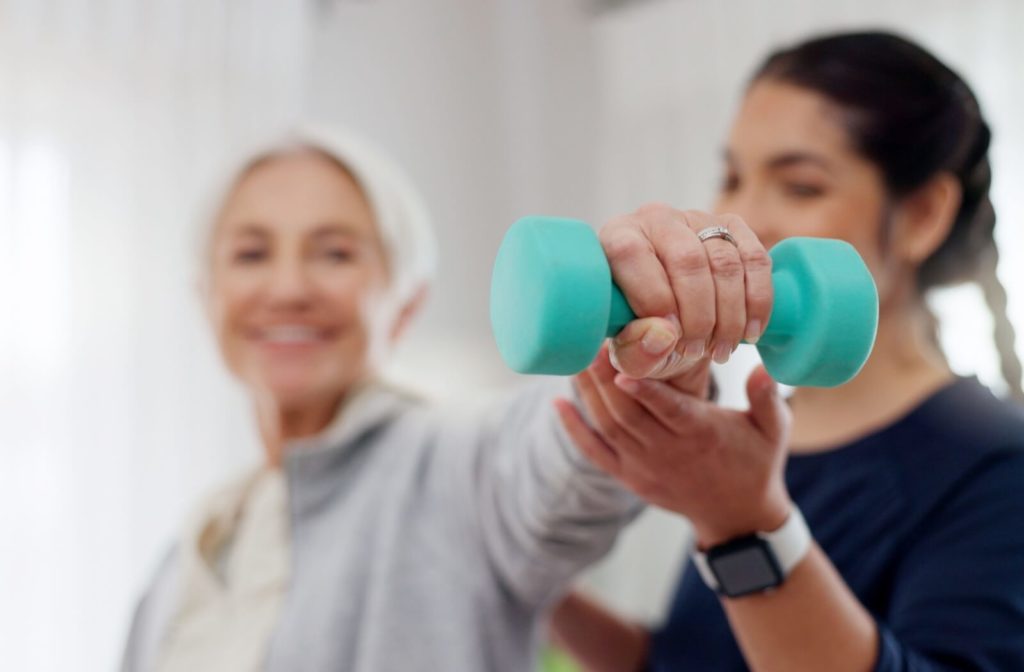Maintaining a healthy lifestyle becomes increasingly important as we age, and weight lifting is an excellent way to support one. However, safety is paramount for senior living, especially when considering weight lifting as part of a fitness routine. This article will explore the benefits of weight lifting for seniors, how to get started safely, and tips for effective weight management.
A consistent and well-managed exercise routine not only improves strength and balance, but also boosts confidence and independence. Remember, age is just a number, and with the right approach, weight lifting can be a safe and rewarding experience for seniors.
The Benefits of Weight Lifting for Seniors
Engaging in regular weight lifting has numerous benefits for seniors, both physically and mentally:
- Improved Muscle Mass and Strength: As we age, muscle mass naturally decreases, leading to weaker muscles and reduced strength. Weight lifting helps counteract this loss by building and maintaining muscle mass.
- Enhanced Bone Density: Weight-bearing exercises, like lifting weights, promote bone health and can help prevent osteoporosis, a common concern for seniors.
- Better Balance and Coordination: Stronger muscles and increased core stability improve balance, reducing the risk of falls—a significant concern for older adults.
- Boosted Mental Health: Regular exercise, including weight lifting, releases endorphins, improving mood and overall mental well-being.
- Enhanced Independence: By improving strength, balance, and coordination, seniors can maintain their independence, perform daily activities with ease, and enjoy a higher quality of life.
Getting Started Safely
Before embarking on a weight lifting routine, seniors should consider the following steps to ensure a safe and effective experience:
1. Consult with Healthcare Professionals
It’s important for seniors to consult with their healthcare provider before starting any new exercise regimen, including weight lifting. A doctor can assess individual health conditions, provide guidance, and recommend modifications tailored to specific needs.
2. Work with a Qualified Fitness Professional
Working with a certified personal trainer who specializes in senior fitness can provide invaluable support. They can help design a personalized weight lifting program, ensuring correct form, appropriate weight selection, and gradual progression.
3. Start Slowly & Progress Gradually
Seniors should begin with light weights and focus on mastering proper technique before increasing resistance. Gradual progression reduces the risk of injury and allows the body to adapt to new stressors.
4. Prioritize Warm-Ups & Cool-Downs
Warm-ups are essential for preparing the body for exercise, increasing blood flow to muscles and reducing the risk of injury. Similarly, cool-downs help the body return to a resting state and promote flexibility.
Tips for Effective Weight-Lifting Management
1. Focus on Core Exercises
Core exercises, such as planks and seated leg lifts, strengthen both balance and stability. Including core workouts in a weight lifting routine enhances overall body strength.
2. Incorporate Functional Movements
Functional exercises mimic everyday activities, making them practical for seniors. These movements include squats, lunges, and step-ups, which improve strength and coordination.
3. Mind the Rest Periods
Allow adequate rest between workouts to aid muscle recovery and prevent overtraining. Seniors should aim for two to three days of rest between weight lifting sessions.
4. Stay Hydrated & Eat a Balanced Diet
Proper nutrition and hydration are vital components of a successful weight lifting program, especially for seniors who need to maintain strength and vitality. A well-balanced diet should include a variety of nutrient-dense foods, such as lean proteins, whole grains, and a colorful array of fruits and vegetables.
Proteins are essential for muscle growth and repair, while vitamins and minerals support overall health and enhance the body’s recovery process. Staying adequately hydrated is also crucial, as it aids in maintaining energy levels and preventing muscle cramps during workouts. By focusing on these nutritional elements, seniors can optimize their performance and achieve their fitness goals.
5. Listen to Your Body
It’s important for seniors to pay attention to their bodies and recognize signs of fatigue or discomfort. Adjusting workouts or seeking medical advice when necessary ensures a safe and enjoyable fitness experience.
6. Engage in Complementary Activities
Incorporating other forms of exercise, such as walking, swimming, or yoga, provides a well-rounded fitness routine. These activities complement weight lifting, enhancing cardiovascular health, flexibility, and overall well-being.
Thinking About Assisted Living?
Weight lifting offers significant physical and mental benefits for seniors, promoting a healthy and active lifestyle. By following safety precautions, consulting with healthcare professionals, and working with qualified trainers, seniors can enjoy the advantages of weight lifting while minimizing risks.
For caregivers supporting seniors on this fitness journey, encouraging and facilitating access to suitable resources, such as personal trainers and wellness programs, can significantly enhance the experience and outcomes. By fostering a supportive environment, caregivers can empower seniors to take charge of their health and well-being. To learn more about senior health and wellness, contact Bentley at Paragon Village in Hackettstown, NJ.


